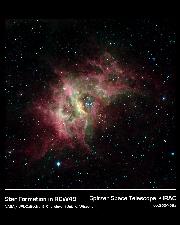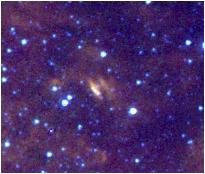Milky Way Galaxy and Planet Research Summary

 UW graduate student Brian Uzpen and I are using data from
the Spitzer Space Telescope's
GLIMPSE
(Galactic Legacy Infrared MidPlane Survey Extraordinaire)
survey to identify stars with excess emission at mid- and
far-infrared wavelengths.
Such signatures indicate the presence of dusty disks or rings of
material around the star.
Pre-main sequence stars often show this phenomenon, but
even more exciting are the main sequence stars which
show an excess. In these systems, the disk of material
is a "debris disk" probably due to collisions of planets and asteroids.
Thus, the Infrared excess is a probable signature of planet formation.
We have made an initial identification (
Uzpen, Kobulnicky et al. 2005 ) of 20+ stellar systems
spanning a range of spectral types from A to K that are candidates
for debris disk, or "Beta-Pictoris" type systems, named after the
prototype star where the debris disk was first discovered in 1984.
Given the large scope of the GLIMPSE survey (260 square degrees of the Galactic Plane)
we anticipate many more such discoveries.
UW graduate student Brian Uzpen and I are using data from
the Spitzer Space Telescope's
GLIMPSE
(Galactic Legacy Infrared MidPlane Survey Extraordinaire)
survey to identify stars with excess emission at mid- and
far-infrared wavelengths.
Such signatures indicate the presence of dusty disks or rings of
material around the star.
Pre-main sequence stars often show this phenomenon, but
even more exciting are the main sequence stars which
show an excess. In these systems, the disk of material
is a "debris disk" probably due to collisions of planets and asteroids.
Thus, the Infrared excess is a probable signature of planet formation.
We have made an initial identification (
Uzpen, Kobulnicky et al. 2005 ) of 20+ stellar systems
spanning a range of spectral types from A to K that are candidates
for debris disk, or "Beta-Pictoris" type systems, named after the
prototype star where the debris disk was first discovered in 1984.
Given the large scope of the GLIMPSE survey (260 square degrees of the Galactic Plane)
we anticipate many more such discoveries.
Back to Chip's Homepage


